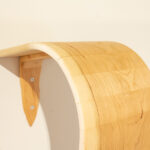 Frank Lukasavitz’s hands are the hands of a maker – a maker of drawings, of tools, wood, steel and models. Of a college – the Milwaukee Institute of Art & Design – and the graduates and traditions he shaped as a leading educator for 50 years.
Frank Lukasavitz’s hands are the hands of a maker – a maker of drawings, of tools, wood, steel and models. Of a college – the Milwaukee Institute of Art & Design – and the graduates and traditions he shaped as a leading educator for 50 years.
Some might say that this man, born in 1930 in rural Wisconsin, could not possibly have anything in common with today’s students. Yet the threads that run through his life are those of many MIAD students, of today’s graduates and of the education excellence the college embodies.
Frank, who recently retired after 100 semesters of teaching, grew up drawing. He “loved to draw and drew all the time,” he says. Although he couldn’t take all the art classes he wanted to in high school, even after moving to Milwaukee, his hands were always busy.
He took a “mechanical class” and learned how to make tools and cabinets. He played the violin, superbly so. After graduating from high school, he found art as a woodworker – as a cooper making barrels.
From there Frank went on to work on the railroad with concrete and hammers. He learned plumbing; was a machinist; worked in a foundry; and went into the printing industry, learning foil mounting. After a stint in the army, he became a photoengraver.
‘Am I good enough?’
Then it was time to get serious, according to Frank. He talked to people at Marquette’s dental school who told him dentistry was not in his future, but that the drawings he had on hand just might be.

So in 1957, at age 27, he started summer classes at the Layton School of Art, MIAD’s predecessor college founded in 1920. “I was so scared,” he recalled, “but I just kept drawing.”
In the fall, he started the Bachelor of Fine Arts program, thinking, “I’m not good enough.” Realizing after about six weeks, that “he could do this,” he began contemplating a Painting or Sculpture major.
Then he discovered Industrial Design, and everything that had come before “just clicked.” In Frank’s case, the rest is truly history.
Working his way through college (he was a designer and model builder for Design Corporation his senior year), he graduated in 1961.
Two years later, Frank re-joined Layton as a faculty member, spending a year setting up what was then known as “the shop,” the 3D lab that he and longtime staff member Steve Lacey made into a resource that continues to be “one of the best in the country.”
Frank then began teaching Methods and Materials in the college’s Industrial Design program, a course still taught today, while also continuing to build up the 3D lab.
He worked under the leadership of design luminary and ID program founder Don Hay, with early colleagues Len Singer, Bruce Brinkwitz and Paul Nelson.
The founding of MIAD Frank soon joined the leadership team of Guido Brink and Jack White, three of seven visionary faculty members at the Layton School of Art who were determined to continue Milwaukee’s leadership in arts education when the board of directors closed Layton over a labor dispute in 1974.
Frank soon joined the leadership team of Guido Brink and Jack White, three of seven visionary faculty members at the Layton School of Art who were determined to continue Milwaukee’s leadership in arts education when the board of directors closed Layton over a labor dispute in 1974.
In that pivotal year, MIAD was founded. Pooling $100 of their personal money and taking no salaries, the seven moved with 33 students to the Third Ward as a leading anchor in what would become Milwaukee’s most creative and historic district. With Guido Brink serving as director/president (1974 – 1976), iconic industrial designer and faculty member Brooks Stevens suggested the new college be called the Milwaukee School of Art.
They were bolstered within one semester by a donation of $15,000 from Sam Johnson of Johnson Wax – one of many companies that employ MIAD alumni today (as SC Johnson).
By 1982, under the tenure of director/president Jack White (1976 – 1983), the college was renamed the Milwaukee Institute of Art & Design. It had 300 students and was accredited by the National Association of Schools of Art and Design.
When Jack White resigned, Frank served briefly as interim president until Terry Coffman began his tenure in August 1983. By 1987 MIAD was accredited by the Higher Learning Commission, and in 1992 the college moved into its present Historic Third Ward location – the former Marine Terminal Building at 273 E. Erie Street.
Between 1974, when MIAD was founded, and 1987, Frank served on the college’s board of directors, “holding every possible position, including chairman.” He was dean of admissions and head of financial aid. All the while, he continued to teach and expand the 3D lab with Steve Lacey.
 At his retirement party, Vice President of Academic Affairs David Martin said, “For 50 years, Frank left his imprint on each and every student who studied at MIAD, and on the art and design they created.”
At his retirement party, Vice President of Academic Affairs David Martin said, “For 50 years, Frank left his imprint on each and every student who studied at MIAD, and on the art and design they created.”
 But Frank’s imprint didn’t stop when students graduated. In addition to shaping a tradition of education excellence, he also built up a tradition that current President Neil Hoffman (who began his tenure in 2008) calls the “Lukasavitz factor.”
But Frank’s imprint didn’t stop when students graduated. In addition to shaping a tradition of education excellence, he also built up a tradition that current President Neil Hoffman (who began his tenure in 2008) calls the “Lukasavitz factor.”
For decades, Thursday night in the 3D lab was known as “dinner night with Frank.” MIAD alumni returned time and time again, to engage the wisdom and wit of one of the college’s most dedicated faculty members.
“I wanted people to not just walk away with a degree, but to be the best people they can be, just like my goal for the college was for it to be the best college it could be.
“The one thing that makes the best college in the world is the graduates – and teachers who have the capability to listen, instead of just talking. I had my evening sessions with students and graduates, and I let them talk until they couldn’t talk anymore….”
For a maker who embodies the best of MIAD faculty and their lifelong connection with students and graduates, Frank was honored at the 2013 commencement with the first MIAD Lifetime Achievement Award.





